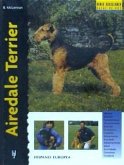The Airedale Terrier, often referred to as the "King of Terriers," holds a fascinating place in the history of dog breeds. Renowned for its versatility, intelligence, and resilience, the breed emerged as a product of necessity and ingenuity during the 19th century in Yorkshire, England. Its origins, role in the region's history, and its diverse uses as a working dog reflect a story of human innovation and adaptation to evolving societal needs. History and Development of the Breed The history of the Airedale Terrier is deeply rooted in the Aire Valley of Yorkshire, a region characterized by its sprawling rivers, fertile lands, and industrious communities. During the mid-19th century, the industrial revolution had transformed much of England, leading to significant changes in societal structures and lifestyles. In Yorkshire, working-class people, including mill workers and farmers, required a dog that could assist with a variety of tasks, from hunting game to protecting their properties. The breed's development began as a deliberate crossbreeding effort to create a versatile dog that could excel in various roles. The primary foundation breeds were the Old English Black and Tan Terrier, a hardy and agile working dog, and the Otterhound, a robust breed known for its excellent scent-tracking abilities and love of water. The resulting offspring combined the terrier's tenacity, intelligence, and agility with the Otterhound's endurance, strength, and scenting prowess. The breed was initially known by several names, including the "Waterside Terrier" and the "Bingley Terrier," reflecting its regional origins. It wasn't until the late 19th century that the name "Airedale Terrier" became widely accepted, honoring the Aire Valley where the breed was first developed. >The Airedale's Role in 19th-Century Yorkshire, England In 19th-century Yorkshire, life was demanding and often harsh. The industrialization of the region brought both prosperity and challenges, particularly for working-class families. The Airedale Terrier emerged as a breed that could meet the practical needs of these families while also providing companionship and protection. One of the primary roles of the Airedale Terrier during this time was as a hunting dog. The Aire Valley was rich in wildlife, including otters, waterfowl, and small mammals, which were both a source of sport and sustenance for local communities. Airedales were particularly prized for their ability to navigate water and track scents over long distances, making them ideal for hunting in the region's rivers and marshlands. Their wiry, weather-resistant coats allowed them to work in the damp, cold conditions typical of Yorkshire's climate. In addition to hunting, Airedales were employed as vermin hunters. Rats and other pests were a constant nuisance in industrial and agricultural settings, and the breed's sharp instincts and quick reflexes made them highly effective at controlling these populations. Ratting contests, popular in the 19th century as a form of entertainment and sport, often featured Airedale Terriers as star competitors. The Airedale's versatility extended beyond hunting and pest control. They were also used as guard dogs, protecting homes, businesses, and livestock from intruders. Their imposing size, combined with their alert nature and courage, made them formidable protectors.
Hinweis: Dieser Artikel kann nur an eine deutsche Lieferadresse ausgeliefert werden.
Hinweis: Dieser Artikel kann nur an eine deutsche Lieferadresse ausgeliefert werden.








